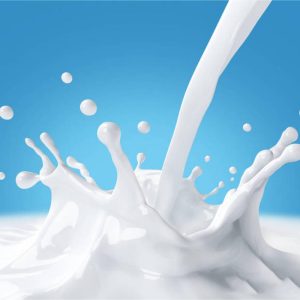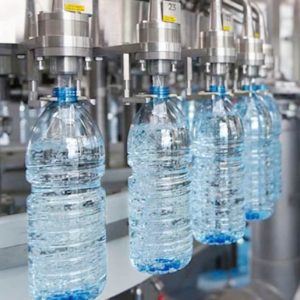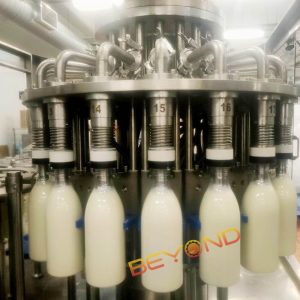Introduction
In the beverage industry, filling machines are the backbone of any production line. They not only determine the efficiency of the operation but also directly impact the quality of the final product. A question we frequently hear from manufacturers is: “Can a water filling machine also be used to fill milk?”
Recently, we received an inquiry from one of our clients in Indonesia: “Our factory currently uses a water filling line, and we would like to know if it can also handle milk. If so, what modifications would be necessary?”
This article aims to answer that question by examining the key differences between water and milk, analyzing the structural and functional differences in filling machines, exploring the feasibility of using a single machine for both, and outlining the necessary adjustments for safe and efficient dual use.


The Fundamental Differences Between Water and Milk
Understanding why water and milk require different handling starts with their intrinsic properties.
1. Physical Properties
-
Water is transparent, low in viscosity, and free of fats and proteins, making it relatively easy to handle.
-
Milk, on the other hand, is opaque, higher in viscosity, and contains fats, proteins, and lactose. Its composition makes it more challenging to process and more prone to changes during storage and handling.
2. Microbial Risks
-
Water is relatively stable, and the risk of microbial contamination is low.
-
Milk is highly perishable and can become a breeding ground for bacteria if not handled properly, requiring stringent sterilization and hygiene control.
3. Temperature and Storage Requirements
-
Water can be stored at room temperature without special considerations.
-
Milk requires cold chain storage to maintain freshness and safety, which adds another layer of complexity to production.
4. Cleaning and Sanitation Needs
-
Water filling machines can be cleaned using standard methods without special requirements.
-
Milk filling machines must undergo high-temperature cleaning, often through a CIP (Clean-In-Place) system, and strict sterilization processes to prevent contamination.
Key Differences Between Water and Milk Filling Machines


The differences in product characteristics naturally dictate differences in machine design.
1. Filling Methods
-
Water filling machines typically use gravity or rotary filling mechanisms. These methods are fast and suitable for high-volume production.
-
Milk filling machines usually employ piston or volumetric pumps with low-oxygen handling to minimize foam and ensure precise measurement.
2. Sealing and Cleaning Systems
-
Water filling machines are generally simpler in structure, with shorter cleaning cycles.
-
Milk filling machines are equipped with complex CIP systems to maintain sterilization before and after each production run, ensuring hygiene and safety.
3. Material Requirements
-
Water machines can be constructed with standard stainless steel.
-
Milk machines require food-grade stainless steel with polished surfaces to prevent fat adhesion and bacterial growth.
4. Temperature Control and Environmental Monitoring
-
Milk filling machines often include temperature monitoring systems to prevent bacterial proliferation during processing.
Why You Cannot Simply Use a Water Filling Machine for Milk
Although it might seem convenient to use one machine for multiple products, direct reuse without modification presents serious challenges.
1. Hygiene and Safety Risks
-
Residual milk in a water line can easily contaminate water, increasing the risk of microbial cross-contamination.
2. Filling Precision and Foam Issues
-
Water filling machines are not designed to control foam. Filling milk with these machines can lead to excessive foaming, affecting volume accuracy and bottle sealing quality.
3. Equipment Longevity and Maintenance
-
Using a water filling machine for milk can accelerate wear and tear, leading to more frequent maintenance and potential downtime.
How to Modify a Water Filling Machine for Milk
If a company still wants to use a single machine for both water and milk, several modifications are necessary:
1. Add a CIP Cleaning System
-
Ensures thorough cleaning and sterilization before and after switching products, preventing cross-contamination.
2. Replace or Upgrade the Filling Head
-
Adaptable to both low-viscosity water and high-viscosity milk, ensuring accurate and efficient filling for each product.
3. Implement Temperature Control and Sterilization
-
Essential for milk handling to maintain safety and product quality.
4. Upgrade Materials
-
Switch to food-grade stainless steel with polished surfaces for ease of cleaning and improved hygiene.
5. Enable Filling Program Switching
-
Allows operators to set different filling parameters and modes for water and milk, providing flexibility and precision.
Conclusion
Water and milk differ significantly in terms of physical properties, microbial risks, storage requirements, and cleaning procedures, so using the same filling machine for both poses safety hazards and production risks. Although dual-use can be achieved through upgrades and modifications, this requires additional investment and increases maintenance and management complexity. Companies should evaluate their production scale and product characteristics to carefully decide between dedicated filling machines or switchable multi-purpose machines. However, to ensure production safety, efficiency, and operational flexibility, it is recommended not to use shared machines—water and milk should be filled using separate, dedicated filling machines.
